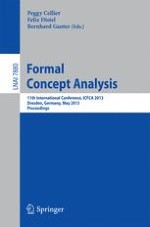This book constitutes the refereed proceedings of the 11th International Conference on Formal Concept Analysis, ICFCA 2013, held in Dresden, Germany, in May 2013. The 15 regular papers presented in this volume were carefully reviewed and selected from 46 submissions. The papers present current research from a thriving theoretical community and a rapidly expanding range of applications in information and knowledge processing including data visualization and analysis (mining), knowledge management, as well as Web semantics, and software engineering. In addition the book contains a reprint of the first publication in english describing the seminal stem-base construction by Guigues and Duquenne; and a position paper pointing out potential future applications of FCA.
